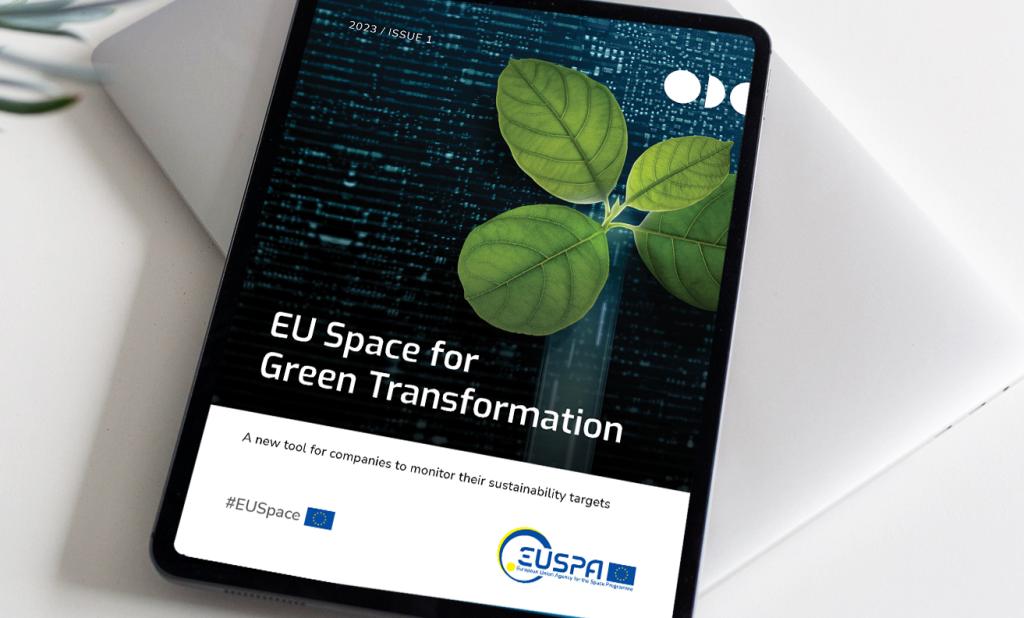EU Space helps drive the green transformation

Climate change is one of the biggest challenges facing humanity today. Overcoming it requires a green transformation – one characterised by a drastic reduction in carbon emissions and a significant increase in sustainable best practices.
Driving this transformation is the European Green Deal, which strives to make Europe the world’s first climate-neutral continent by 2050. But to achieve this goal, companies must take a deep look at their internal operations, as well as their supply chains, to identify opportunities for reducing their own environmental footprint.
This is where EU Space comes into play.
The EU Space Programme, including Copernicus, Galileo and EGNOS, can play a critical role in supplying the information companies need to monitor environmental indicators, reduce their environmental impact, become more sustainable and drive the green transformation.
“EU Space data and services are an important asset to support the implementation of the Green Deal,” says EUSPA Executive Director Rodrigo da Costa. “Businesses in particular stand to benefit from a myriad of possible applications for EU Space data, which translates into greener practices, cost reductions and increased efficiency.”
EU Space for Green Transformation, a new report by EUSPA, introduces the Green Deal and its implications for companies. It also presents detailed examples of how various industries, including energy, road transport, aviation, agriculture, forestry and mining, are leveraging the power of EU Space to drive their sustainability journeys.
EU Space data supports the shift to renewable energy
According to the Report, the EU Space Programme is set to support the energy sector’s shift from fossil fuels to renewables – a process that starts with site selection.
Choosing the right location for renewable energy infrastructure is a key prerequisite to efficient energy production. Connections to the grid, historical weather data (solar irradiance, windspeeds and directions, marine currents, etc.), as well as oro- and topographical characteristics, are all crucial parameters in this process.
EU Space data makes finding the optimal site easier. For example, using information gathered from Copernicus’ satellites and atmospheric models, the Copernicus Atmosphere Monitoring Service produces global irradiation models that the renewable energy sector can use to make informed decisions on where to best place solar panels. Considering Copernicus’ ability to monitor wind and marine currents, similar applications can be used to optimise the location of wind turbines and tidal power generation plants.
EU Space offers substantial environmental benefits
Once the infrastructure is built and operational, it must be maintained – something that becomes all the more challenging when the solar panels and wind turbines are located in difficult-to-reach and remote locations.
Here too EU Space can help.
The precise positioning services offered by Galileo and EGNOS, together with the latest developments in computer vision-aided navigation, enable the use of unmanned aerial vehicles (UAVs), or drones, to efficiently, effectively and safely inspect renewable energy infrastructure.
GNSS-enabled drones are already used to remotely detect solar panel hotspots, which can reduce power generation, and inspect wind turbine structures. With the forthcoming Galileo High Accuracy Service, this capability will become even more efficient and widespread.
“Whether it be increasing the efficiency of renewable energy infrastructure, enabling more efficient flightpaths or implementing precision agriculture operations, as this Report makes clear, the cumulative environmental benefits enabled by the EU Space Programme are simply substantial,” concludes da Costa.
To learn how your company’s sustainability journey can benefit from EU Space data and services, download the full EU Space for Green Transformation report here. Or contact us at market@euspa.europa.eu.
Media note: This feature can be republished without charge provided the European Union Agency for the Space Programme (EUSPA) is acknowledged as the source at the top or the bottom of the story. You must request permission before you use any of the photographs on the site. If you republish, we would be grateful if you could link back to the EUSPA website (http://www.euspa.europa.eu).